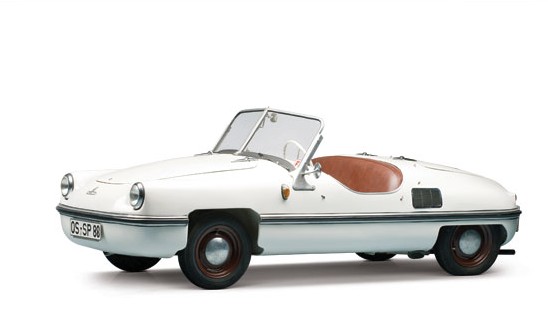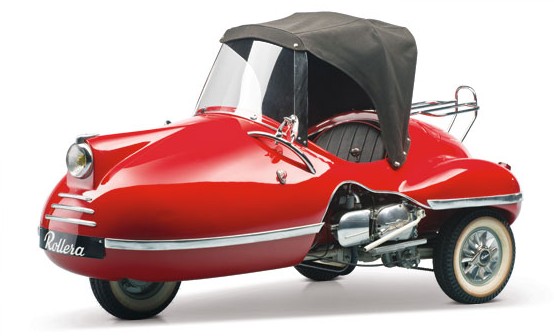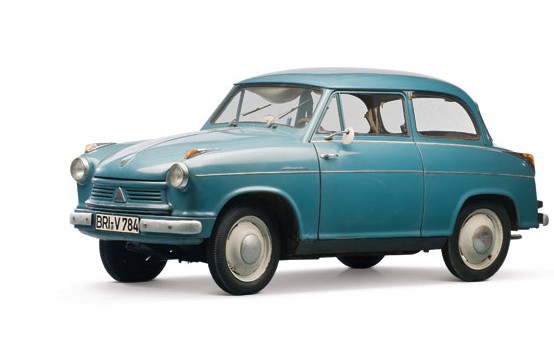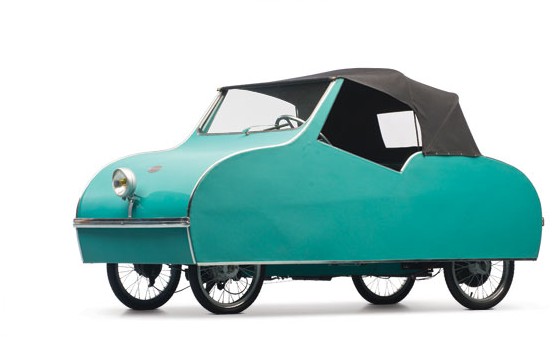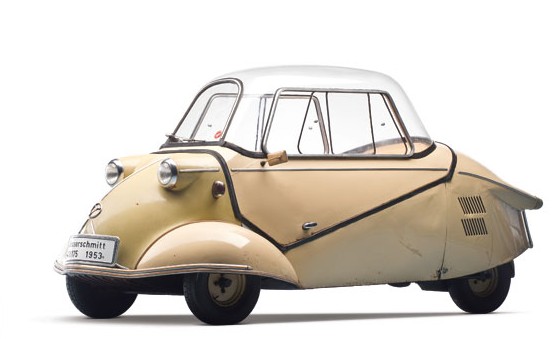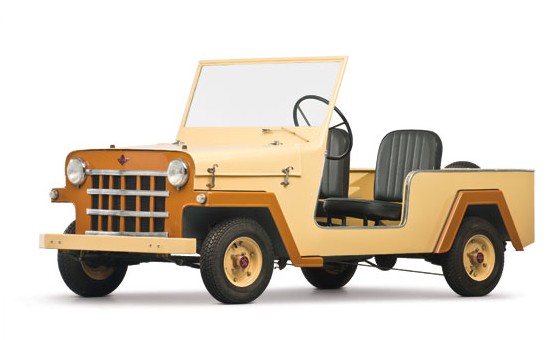The Bruce Weiner Microcar Collection
Offered by RM Auctions | Madison, Georgia | February 15-16, 2013
____________________________________________________________
1951 Reyonnah

Reyonnah (which comes from the name of company founder Robert Hannoyer spelled backwards), was a short-lived automaker from Paris. It was only around from 1951 through 1954 and this was the car that they built.
A single-cylinder engine was used, either of the 125cc or 175cc variety. The 175cc put out 8.5 horsepower. It will do 63 mph and can seat two people – the passenger directly behind the driver. You’ll probably notice the weird angle this thing is parked at – that’s because the front had a very wide track compared to the rear – but, when parked, the front wheels could be brought in closer – to make it easier to park. When this happens, it raises the front of the car up into the air. Weird. This should sell for between $75,000-$100,000. Click here for more info.
Update: Sold $184,000.
____________________________________________________________
1985 Sinclair C5

Most of the cars from this sale are from the 1940s through the 1960s. Not this one. Designed by Sir Clive Sinclair and built by the Hoover vacuum people, the C5 was built for 1985 only. It had pedals (like a sit-down bicycle) but was also powered by an electric motor making capable of 15 mph. But a street-legal 15 mph tricycle – that could be driven without a driver’s license – was dangerous. And the fact that it was built and marketed primarily in England and had no top, made it unsuitable for the general climate. It was a massive flop, even though 17,000 were sold in 1985. It should sell for between $3,000-$5,000. Click here for more info.
Update: Sold $4,600.
____________________________________________________________
1968 Authi Mini 1275C
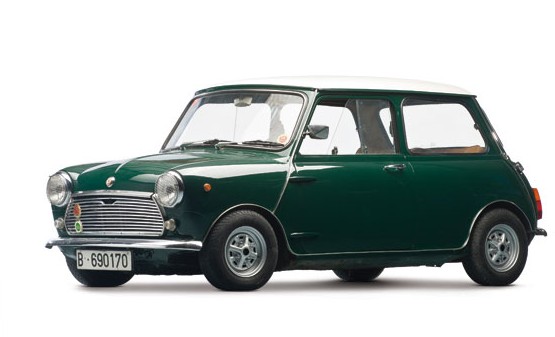
Wait, just a plain ol’ Mini Cooper after all these weird cars? Well, kind of. It isn’t a Morris or Austin or even a Mini-badged Cooper. It’s not even British-built. Authi – of Pamplona, Spain, – built the Mini under license from 1968 through 1975. This is from their first year of production and it has the 1275cc Mini engine (1.3 liters) making about 54 horsepower. Authi was an automotive production plant, primarily, and built cars for BMC under the Austin brand. But the Mini they branded themselves. The Authi plant became part of SEAT in 1976. They built about 140,000 Minis with their name on it, but you hardly ever see them. This one should sell for between $20,000-$30,000. Click here for more info.
Update: Sold $28,750
____________________________________________________________
1956 VELAM Isetta

Another Isetta from another brand. In this case, this Isetta was built by VELAM – a French company that built them under license between 1955 and 1958. There were slight variations – the body was more rounded and there is a big, bold “VELAM” script across the front door. It uses a 236cc split-single-cylinder engine making about 9.5 horsepower. It could do 50 mph and only about 5,000 were built. It should bring between $30,000-$40,000. Click here for more info.
Update: Sold $37,375.
____________________________________________________________
1959 Bond Minicar Mk F
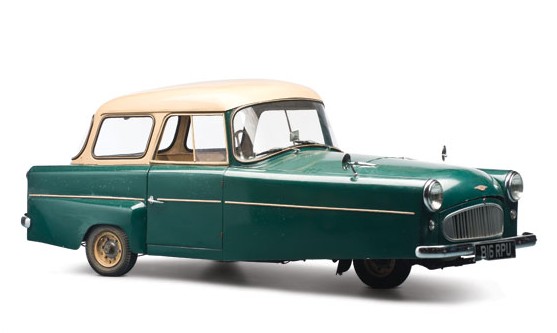
The Mark F iteration of the Bond Minicar was the second-to-last version offered for sale. Built from 1958-1963, the Mk F is differentiated from its immediate predecessor by its larger engine – a 247cc single-cylinder making 12 horsepower. There were different body styles offered – this is a hardtop. It was capable of 55 mph and there was a four-seat version available (I honestly can’t tell if this has four seats or two). Only 6,493 were made in total. This one, with some of the tiniest looking wheels in comparison to overall car size I’ve ever seen, should sell for somewhere in the range of $15,000-$20,000. Click here for more info.
Update: Sold $11,500.
____________________________________________________________
1959 Frisky Family Three
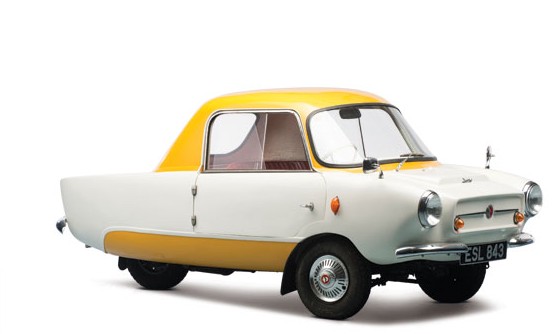
The Frisky was one of those cars that was produced by multiple companies – all of whom couldn’t help but go bankrupt at some point. The second company to use the Frisky trademark was Frisky Cars Ltd and they introduced the Family Three in late 1958. It was essentially a three-wheeled version of the Frisky Coupe that could be driven with a motorcycle license. The company was reorganized the following year (1959) and the model names were changed. This car uses a rear/mid-mounted 197cc single-cylinder making 9.5 horsepower. It could do 50 mph and should sell for between $15,000-$20,000. Click here for more info.
Update: Sold $57,500.
____________________________________________________________
1959 PTV 250

PTV sold their Spanish-built microcars from 1956-1961. Two models were offered, the 250 and the 400. Both were tiny two-door convertibles that differed only in engine size. The 250 used a rear-mounted 247cc single-cylinder making 11 horsepower. Top speed was around 45 mph. Most of the cars were sold in Spain, although same made it to Portugal. Between the two models, a total of around 11,000 were sold. This one will sell again for between $40,000-$50,000. Click here for more info.
Update: Sold $46,000.
____________________________________________________________
1939 New-Map Baby

This unrestored pre-war microcar from French motorcycle manufacturer New-Map is very rare. New-Map was founded in 1920 in Lyon and it built its first itty-bitty car in 1938. It was called the Baby and it used a 100cc single-cylinder Sachs engine – the same one from their motorcycles. Only about 1,000 were built. In 1946 they re-introduced the car with a 125cc engine but it only lasted one year. This one should bring between $15,000-$20,000. Click here for more info.
Update: Sold $21,850.
____________________________________________________________
1957 Victoria 250
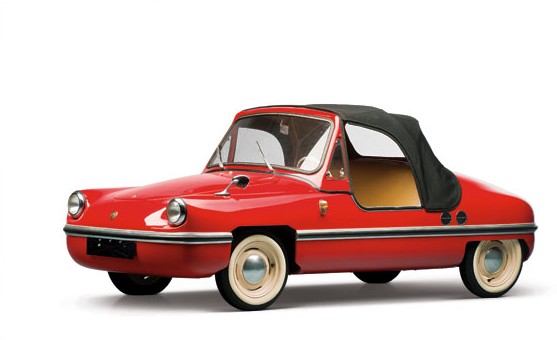
This little German fiberglass convertible was originally marketed as the Brütsch Spatz. Victoria was a motorcycle manufacturer in Nuremberg and they entered a joint venture with another company to form BAG (Bayerische Autowerke GmbH), to produce these cars under license as the BAG Spatz. But first, they re-engineered the car to make it stronger and safer – and added a fourth wheel from the original three-wheeled design – this got them out of paying licensing fees. Lastly, they pumped the displacement up to 250cc from 200cc. The single-cylinder made 14 horsepower. While BAG produced the Spatz, Victoria produced the car concurrently, from 1956 through 1958 as the Victoria 250. Only 729 of the Victoria-badged cars were sold. This one should sell for between $35,000-$45,000. Click here for more info.
Update: Sold $37,375.
____________________________________________________________
1958 Goggomobil Dart
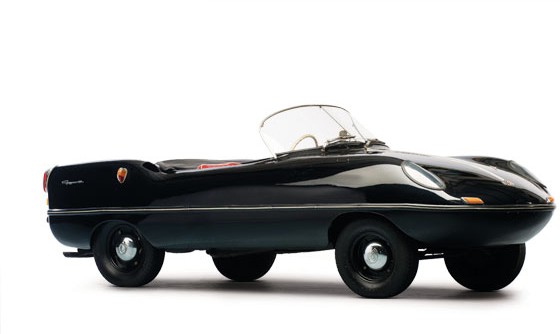
Goggomobil was a German microcar company, but in 1959, Buckle Motors of Sydney, Australia designed a two-door roadster based on the small Goggomobil Coupe. Somehow, they were able to market the cars under the Goggomobil name and they called it the Dart. It used the same 293cc straight-two making 14 horsepower (with an optional upgrade to 392cc and 18 horsepower). The body was fiberglass and it was produced through 1961. Only about 700 were built. It’s an Australian car with a German name and it could be yours for $35,000-$45,000. Click here for more info.
Update: Sold $54,050.



